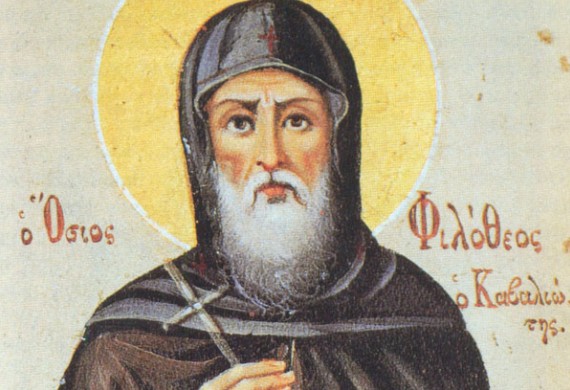Saint Philotheos was born in 1526 AD. in Chrysoupolis, Macedonia, Greece (near city of Kavala).
His parents were from a province in Asia Minor, specifically from the city of Elateia. For fear of the Agarines (Turks), they came to Chrysoupolis, where his father died after the birth of his two siblings. These children were seized by the Turks. For that reason, their mother Evdokia was in absolute pain and in order to alleviate it, she secluded herself in a women’s monastery.
But one time, at a festival of a men’s monastery that she went for the fest, she met her two children and with much happines she heard the story of the salvation of her children, from the abbot’s mouth. Theophilos that was his original name, he showed great willingness in this monastery and for that he became a monk with the name Philotheos.
In 1551 AD and at the age of 25, he went to Agios Oros (Mount Athos ) and specifically to the convent of the Holy Monastery of Dionysios, where his ascetic struggles became an example to many brothers.
Later, seeking more peace, pretending to have fallen ill and lost his hearing, he retreats to a cave outside the monastery. There, he became a wonderful ascetic monk and conqueror of demons. When his feigned illness was discovered, he was forced to change his place of residence, so that he would not be honored. In his new residence he had had three students.
God, for his efforts, rewarded him with the gift of foresight.
He died peacefully at the age of 84 (1610 AD). He had instructed his disciples not to bury his body, but to let it be eaten by the beasts of the forest. The all-merciful God, however, covered it with light, from which a monk, being guided, took his cart and handed it over to the disciples of the saint.
The cara is preserved to this day in the monastery of Petra, in the province of Thessaliotis, in a silver case, and is held in high esteem by the faithful. In 1972 AD, part of the holy relic of the saint was transferred by the blessed abbot Archimandrite Gabriel from the Koronis monastery to the Dionysiou monastery.
The life of the saint was written by the monk Daniel Dionysiatis, copying an earlier codex, which was translated by the monk Agapios Landos (1802 AD) and published later (Venice 1872 AD).
Translated for Enomeni Romiosine from a Greek text taken from the website:
https://www.saint.gr/2561/saint.aspx
Saint Philotheos of Dionysiou Monastery on Mount Athos

